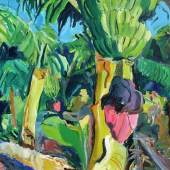JUAN USLÉ NORTE ABIERTO
-
Ausstellung14.09.2023 - 28.10.2023
Root is a new installation by Willem de Rooij, developed especially for Galerie Thomas Schulte. Touching on notions of identity and nationalism, it juxtaposes a seventeenth-century painting on loan from the Stadtmuseum Berlin with thirty-four unique photographic responses made by De Rooij.
In the seventeenth century, the Dutch Republic housed many prolific painters who developed numerous specialized painting genres. Individual artists cross-appropriated each other’s formal and iconographical techniques, which led to a rich and complex visual culture. Because of their innovations, Dutch artists became sought after by wealthy patrons across Europe.
One of them, Willem Frederiksz van Royen (ca. 1645, Haarlem, NL–1723, Berlin), arrived in Berlin from the Dutch Republic in 1669 to become a court painter to Friederich Wilhelm, Elector of Brandenburg, and his successor, Friederich I. Van Royen later became one of the founders of the Akademie der Künste, and after, a director and a professor there. Inspired by artists such as Melchior d’Hondecoeter, he specialized in flower still lifes and menageries. These were decorative genres that were popular with the elites of the time, and Van Royen’s works both recorded and idealized their lifestyles.
Today, a number of Van Royen’s works are still located in Berlin at the state and city collections, though many were looted in the Second World War. In a small still life from 1712, Orangen, an einem Faden aufgehängt, now in the Hermitage in Saint Petersburg, a cluster of oranges is depicted hanging on a string. 1 In the Dutch Republic, oranges at the time connoted royalism, a reference to the Dutch Royal Family, the House of Orange, and many painters used this motif to express their political convictions. 2 Today, the color orange still signals support for the Dutch nation-state and its policies.In the seventeenth century, Dutch farmers cultivated a great variety of orange-colored carrot types that became popular export products. There is no proof that the resulting ‘hype’ was linked to monarchism, but it is known that in 1758, anti-monarchists from The Hague forced local vegetable sellers to hide their orange carrots. 3
Perhaps Van Royen had the monarchy and his native country in mind when he found an anthropomorphic carrot at a Berlin market on July 18, 1699. On the back of the painting that he made of the carrot, Van Royen describes that it ‘was grown in a garden at St Jürgen’s Gate’. 1 That means this work was thought of as a realistic depiction of an actual object – unusual for art of the time, though not for Van Royen; the above-mentioned oranges and a striking pair of small still lifes depicting tulips2 are equally naturalistic. Van Royen’s carrot still life is today part of the collection of Berlin’s Stadtmuseum and is registered there under the title Rübe. 3
Willem de Rooij (b. 1969, Beverwijk, NL) moved from Amsterdam to Berlin in 2006 as a fellow of the DAAD’s Berliner Künstlerprogramm. Since then, he has been a professor at the Städelschule in Frankfurt am Main and from 2015, a mentor at the Rijksakademie in Amsterdam. He is co-director of the BPA// Berlin Program for Artists, a post-graduate mentoring program he founded in 2016 with colleagues Angela Bulloch and Simon Denny. De Rooij investigates the production, contextualization and interpretation of images through various media. Appropriation and collaboration inform his methods and facilitate research in art history and ethnography. Throughout his thirty-plus-year career, De Rooij, time and again, scrutinizes visual and conceptual renderings of power. Since his 2010 installation Intoleranceat Berlin’s Neue Nationalgalerie, he has created several projects that incorporate the display of paintings by seventeenth-century Dutch artists such as Hondecoeter, Jan Weenix, and Dirk Valkenburg, who were all part of the development of the genre that became known as the hunting still life. De Rooij’s installations demonstrate how these artists merged notions of exoticism with nationalism in a push to promote the Dutch empire.
Orange, a work from 2004 that De Rooij made with his longtime collaborator Jeroen de Rijke (1970–2006), is a slideshow of eighty-one monochrome shades of orange. It thematizes the relationship between Dutch nationalism and the racist impulses that informed the development of analogue photographic technology.
1 Also known as St Georg’s gate, located around Alexanderplatz
2 https://www.natur-entdecken-pankow.de/schlossparks-und-adelssitze-2/royen-willem-frederik-van-rote-papageientulpe-gk-i-3379-2/
3 https://sammlung-online.stadtmuseum.de/Details/Index/173915
-
06.11.2020 - 10.10.2021Während immer mehr Museen in den umliegenden Ländern temporär schliessen müssen, dürfen wir uns...
-
26.04.2024 - 29.09.2024Barry Le Va (1941–2021) gilt als Erneuerer der Skulptur in der Kunst nach 1960. Das...
-
21.09.2018 - 20.01.2019Das Kunstmuseum Liechtenstein widmet dem aus Russland stammenden Künstler (* 1959), der heute in...
-
Das Liechtensteinische Landesmuseum ist eine öffentlich-rechtliche Stiftung des Fürstentums...
-
30.03.2025 - 30.11.2025Die renommierte Künstlerin Rebecca Horn ist ab diesem Wochenende mit einer beeindruckenden Arbeit...
-
14.09.2023 - 28.10.2023
Dienstag bis Sonntag 10–17 Uhr
Donnerstag 10–20 Uhr
Montag geschlossen














